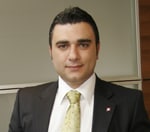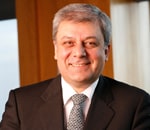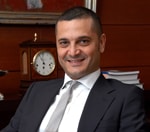Turkish Banking
Turkey has a robust banking system that is ready to support the country’s economic growth.
By Gordon Platt
 |
|
|
Turkey’s banks have followed cautious lending policies under the watchful eye of an effective regulator and are well capitalized and prepared to support future growth in the economy. “Loan growth will likely not be significant this year and may even be zero,” says Burak Tansan, executive vice president at Akbank, Turkey’s largest bank by market capitalization. Economists expect Turkey’s gross domestic product to decline by about 5% in 2009 and to rise by 2% to 3% next year.
With its extensive branch network and strong balance sheet, Akbank aims to achieve higher-than-average growth for the industry as a whole once the economy gains momentum, Tansan says. The banking sector in Turkey has excellent prospects for growth, he says, because Turkey is an underpenetrated market. “Loan volumes in Turkey are still low relative to the size of the country’s economy,” he points out. Loans account for just 35% of GDP, well below the eurozone average of 150%. “In addition, the Turkish banking system’s leverage, as measured by assets per share equity, is only eight, as compared to global bank leverage of 20, 30 or even 40 times equity,” Tansan says.
There are already signs that Turkey’s economic contraction is easing, Tansan notes. The rate of decline in industrial production, for example, is slowing and could soon be in an upward trend, he says. The banking industry could be leading the way during the recovery, he adds. “After being restructured in the crisis of 2001, Turkey’s banks are the best in the world in terms of the strength of their capital structures,” Tansan says. “All of them are very healthy banks. They are not hampered by exposure to derivatives or subprime risks and are in a good position to benefit once the economy recovers,” he points out.
Tourism is another sector that will lead the recovery, Tansan says. Cruise lines and health resorts will benefit from an increase in the number of tourists and in the amount of money they spend. Turkey will need to make investments in ports, however, if it is to take advantage of the growth opportunities, he says. “The insurance industry is also very prosperous and will enjoy further growth, particularly in their pension business,” he adds.
The dramatic drop in Turkey’s inflation rate from 55% in 2000 to the current level of just above 6% has changed the behavior of consumers and investors, according to Tansan. “When inflation was high, people and companies were afraid to invest,” he says. “The decline in inflation has had a positive impact on investment behavior. As investment behavior changes, offering sophisticated investment services to customers will be a key source of competitive advantage for banks,” according to Tansan.
Tolga Egemen, executive vice president of Garanti Bank, one of Turkey’s largest and most profitable banks, says his institution is the perfect example of how the country’s banks have returned to basics following the economic crisis of 2001. “What sets us apart from our peers is that we get most of our revenue from conventional, real, sustainable banking and not from trading and securities,” Egemen says. “We are the closest bank to our customers, which enables us to monitor the position of each customer and continue providing loans if the customer is in good shape.”
As a result of its close customer contact, Garanti Bank has the lowest proportion of non-performing loans, despite being the biggest lender, Egemen says. “Turkey’s banks are very profitable and well capitalized,” he says. “Our capital ratio of 17.8% is the highest in the world.”
Turkey is unique in its attraction to foreign investors as a big emerging market, according to Egemen. “In the new world that is evolving, growth won’t come from the old [developed] countries, where leverage will have to come down,” he says. “Population increases and consumption characteristics are changing in favor of emerging markets.”
Turkey has made critical investments in its legal and regulatory infrastructure to prepare for entry into the European Union. “With our reliable institutions, you feel more comfortable investing here compared to Russia and China,” Egemen says.
 |
|
|
Mahmut Magemizoglu, deputy general manager of Isbank, Turkey’s largest bank by assets, says there were two major trends related to the global financial crisis that had a significant impact on the operations of Turkish banks. First, there has been a sharp decrease in interest rates, as the Central Bank of Turkey cut its overnight borrowing rate in steps from 16.75% last November to 7.75% in August 2009. The decline in funding costs for the banks resulted in a widening in the net interest margin and a rise in net interest income. Second, there was an increase in the delinquency rates of loan portfolios beginning in the fourth quarter of 2008, Magemizoglu says.
“However, as a result of the conservative lending policies, 100% provisioning for non-performing loans and appropriate restructurings, there has been an improvement in asset quality in 2009,” Magemizoglu points out. Furthermore, over the past four quarters there has been an upward trend in the level of collections on non-performing loans, he adds.
“We expect a gradual recovery in economic activity in the fourth quarter of this year as a result of the measures taken by the central bank and the government, along with the return of confidence among individuals and the business sector,” Magemizoglu says. A likely improvement in global market conditions will also help, he says.
 |
|
|
Deposits have always been the major source of funding for Turkish banks. “This turned out to be a clear advantage during the global financial crisis, when many foreign banks encountered contagious liquidity problems because of risk aversion in credit markets,” Magemizoglu says. There was a decline in the number of banks participating in syndicated loans and in the rollover amounts, he says, but the stability of core deposits ensured a healthy liquidity profile for the system.
The global financial crisis has increased interest in participation banking, which is gaining market share in Turkey, says M. Fatih Bulac, vice president and head of international financial institutions at Türkiye Finans. “The very core of Islamic banking is to consider the social implications of all business transactions and to serve the well-being and welfare of the entire society,” Bulac says. “Participation banking is based on the direct participation in production, manufacturing and servicing as an integral part of the real sectors of the economy.”
None of the participation banks hold engineered financial products as assets, since they follow the principles of interest-free banking, he says. Türkiye Finans has become even more cautious and conservative as a result of the crisis. “We amended certain collateral and security structures and became more selective in accepting new customers,” Bulac says.
 |
|
|
The availability of interest-free instruments, such as sukuk-like bonds, will help to increase the flow of international funds from the Gulf into Turkey, Bulac says. “Turkey recently issued revenue-indexed bonds, but the Gulf investors had some compliance concerns, since these bonds did not incorporate an exact sukuk structure,” he explains. “Eventually, a conveniently structured sukuk issuance by the Turkish treasury would attract a substantial flow of funds.”
National Commercial Bank, the largest bank in Saudi Arabia, holds a nearly 65% stake in Türkiye Finans. “As a subsidiary of NCB, our bank will play a major role in terms of trade and investment ties between Saudi Arabia, elsewhere in the Gulf and Turkey,” Bulac says.


